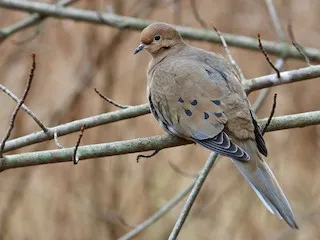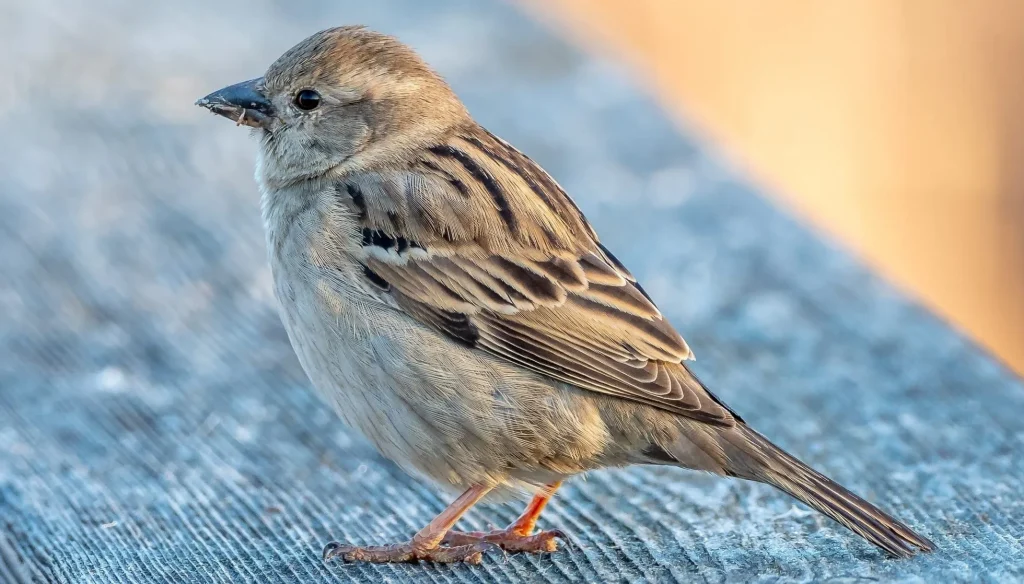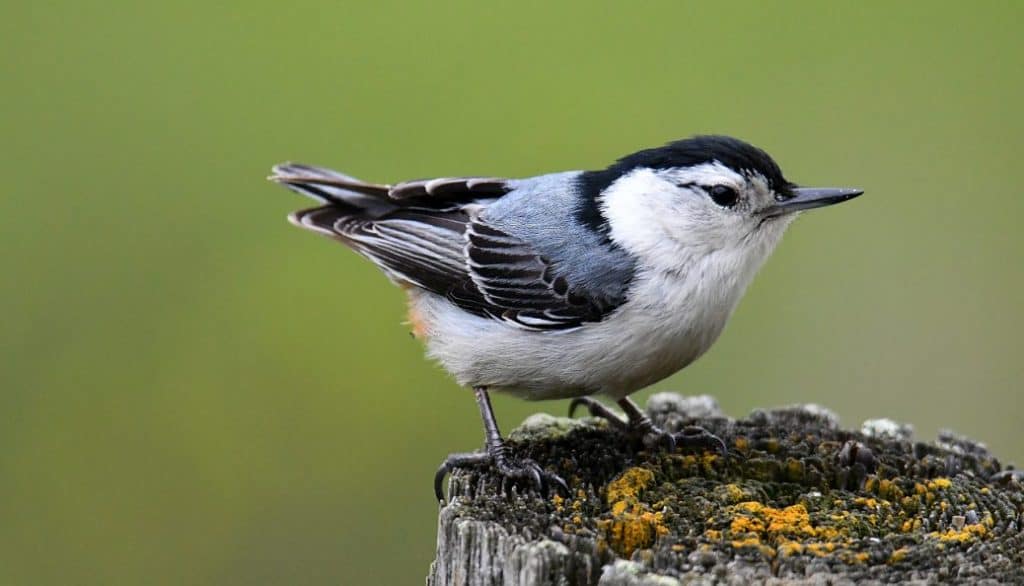Last Updated on: February 5, 2025
Idaho is also known as The Gem State. It is a fitting nickname because it is home to many gemstones and minerals, including gold, zinc, copper, star garnet, jade, opal, aquamarine, and topaz, among others.
However…
There’s another reason why its nickname is appropriate. Aside from natural resources, it is abundant with natural beauty and scenic areas, including steep canyons and snow-capped mountains. It is also bordered by boreal forests and vast deserts. Its varied landscape is one of the reasons you will find a long list of birds of Idaho.
What are the most common birds in the state? Find out in this guide!
A Rundown Of The Most Popular Birds Of Idaho
1. House Finch

A year-round resident in Idaho, the house finch is more common in the winter than in summer. While it is found throughout the state, they are not as frequent in the eastern portion.
House finches are approximately 6 inches with a wingspan of 10 inches. Males are rosy-red around their faces and in the upper breast. A red rump is visible when they are flying. They have brown streaks on the tail, belly, and back. Meanwhile, female house finches are pale brown.
The house finch has varied habitats in Idaho, including farms, parks, backyards, and forest edges. You can attract them in backyard feeders with nyjer seeds and black oil sunflower seeds.
2. Red-Winged Blackbird

The red-winged blackbird is striking! The body is mostly black with a red-orange patch on the wings. However, the latter can be seen only in males. Females have streaky brown bodies.
Red-winged blackbirds are more common in the summer, but you can occasionally spot them as well in the winter. You will often see these birds perching on telephone wires. They also like being around water, such as marshes.
They are frequent visitors of bird feeders. If you want red-winged blackbirds to come to the backyard, provide them with cracked corn and mixed grains.
3. Mourning Dove

One of the most popular backyard birds in Idaho, mourning doves are small birds with long tails and plump bodies. They are light brown with black spots.
They are most frequent in Idaho from April to September, although they can stay year-round. Your best chances of seeing mourning doves are in prairies and grasslands, but they can also be found in backyards.
Up to 99% of the diet of a mourning dove is seeds. Fill a bird feeder with cracked corn, peanut hearts, and sunflower seeds if you want them to visit.
The mourning dove has a crop, which is an enlarged part of the esophagus. This is where they hide seeds collected from the ground.
4. Song Sparrow

Their colors may not be as remarkable as the other common backyard birds in Idaho, but song sparrows are a joy to have around. They have sweet songs that males use to attract female birds and defend their territories.
The numbers of song sparrows are highest in Idaho in the summer, but some can remain even in the winter. Check them out in wet, open, and shrubby areas. You will often see them perched low on the ground and singing.
The song sparrow will eat insects, including midges and caterpillars. Spiders, earthworms, blackberries, and wheat are also consumed by these birds.
5. Black-Capped Chickadee

The name is a reference to the most notable physical feature of the chickadee – its black cap. They have blackish gray backs and wings while the cheeks are white. While they are small, they have oversized heads.
Aside from their appearance, another easy way to identify a black-capped chickadee is to listen to its sounds. They have unique and loud vocalizations, which include a two to three-note whistle.
Black-capped chickadees are in Idaho year-round. They will visit backyard feeders with peanut butter, peanuts, sunflower seeds, and suet.
6. House Sparrow

While there can be slight variations between sexes, house sparrows have white cheeks, brown and gray heads, gray bellies, and brown and black backs.
House sparrows are non-migratory birds. They stay in Idaho throughout the year, and you will find them even in urban areas. They can even come to your hand when you have seeds on your palm.
Fill your bird feeders with millet, sunflower seeds, milo, and corn if you want a house sparrow to visit your backyard.
7. Dark-Eyed Junco

One of the most popular winter birds in Idaho, the dark-eyed junco has a dark gray or brown upper body. The underbelly and breast are white.
Conifer and mixed woods are the preferred habitats of dark-eyed juncos. In the winter, they are popular sights in parks and backyards, especially when there are well-stocked feeders with black oil sunflower seeds, millet, and cracked corn.
Another easy way to identify a dark-eyed junco is to listen to its high-pitched song, especially during the breeding season.
8. European Starling

Present in the state throughout the year, European starlings are “introduced” species in Idaho. They were brought by Shakespeare enthusiasts in the 1800s.
The European starling is about the size of an American robin. From a distance, the body looks glossy black. When you look closer, however, you will see that it has blue, green, and purple hues.
Insects like caterpillars, beetles, and flies form most of the diet of European starlings. They also eat fruits, including mulberries, cherries, and blackberries. Plus, they will visit bird feeders with peanuts, cracked corn, suet, and black oil sunflower seeds.
While European starlings are among the most common backyard birds in Idaho, they are often an unwelcomed sight. They are invasive species and can scare more desirable birds.
9. Yellow Warbler

If you are planning a bird-watching trip in Idaho, the yellow warbler should be on your itinerary. Their sightings are most common in the breeding season.
The yellow warbler might be small, but it has a commanding appearance. Its bright yellow body and yellow green back make it a visual treat.
Insects and worms are among the favorites of yellow warblers, which they pick from the ground or in trees. In the summer, they can come to feeders with grains, seeds, and berries.
10. Eurasian Collared Dove

Originally from Europe and Asia, the Eurasian collared dove is one of the most popular backyard birds in the Gem State.
Some of the most common physical features include a plump body, long tail, and small head. It is light brown to gray with hints of white in the tail feathers. It also has a narrow black like around its nape.
Eurasian collared doves are not shy. They are present even in areas with humans, so do not be surprised to see them in the backyard. They will visit, especially when there are insects, seeds, and grains to eat.
11. Brown-Headed Cowbird

The best time to see a brown-headed cowbird in Idaho is in the summer. It stays in the state during the breeding season, which runs from April to September. There are a few; however, that will stay throughout the year.
Males are black with short tails and brown heads. On the other hand, females are brown with light streaks.
Known as brood parasites, brown-headed cowbirds do not build their nests. Instead, females will deposit their eggs in the nests of other birds.
They will eat almost all kinds of seeds. They are frequent visitors of backyard feeders, often arriving in large groups.
12. Downy Woodpecker

With a length of 5.5 to 6.7 inches, the downy woodpecker is the smallest woodpecker not only in Idaho but in North America.
It has a checkered black and white pattern throughout the body, making it easy to spot. Nonetheless, it has a similar appearance to hairy woodpeckers, so the two are often confused. Males are distinguished from females through the red patch on the top of the head.
If the downy woodpecker is on your Idaho bird-watching itinerary, you will be happy to know that they stay in the state year-round. They are more common in the winter than in summer.
Downy woodpeckers do not sing. Instead, they will drum on metal or wood, which makes it sound like they are singing.
13. Yellow-Rumped Warbler

The physical appearance of the yellow-rumped warbler can vary depending on the location. However, it is common to have yellow flashes on the rump, face, and sides. Meanwhile, they have black wings with white lines.
If you want to see a yellow-rumped warbler, you should head to northern Idaho, which is where the birds stay during the breeding season.
The preferred habitat of the yellow-rumped warbler is coniferous forests. In the winter, they will visit open areas with fruiting shrubs. They can also come to a backyard with feeders that contain peanut butter, raisins, and suet.
14. Northern Flicker

These large backyard birds have brown-gray bodies with black spots throughout. They are also recognizable with their white patch on the rump, which is visible in flight.
Forests edges and open woods are some of the places where these birds are frequently seen. They stay in Idaho year-round, but their sightings are more prominent in the winter than summer.
It is possible for northern flickers to visit backyards, especially when there are suet feeders. They spend a lot of time on the ground using their curved bill to forage food, including beetles and ants.
15. Mountain Bluebird

The mountain bluebird is the state bird of Idaho, so it deserves a spot on this list. It is not as common as the others mentioned.
These native birds have striking colors, making them a head-turner. The backs can range from turquoise to sky blue. The underbellies and breasts are white. There is also a thin white eye-ring.
Prairies and icy tundra are some of their most common habitats. They are rare around human settlements, but you can try attracting them to the backyard by adding fresh berries in feeders or planting fruiting vines.
16. Black-Billed Magpie

Present year-round in Idaho, black-billed magpies have black backs, chests, and heads. The sides and shoulders are bright white. Plus, they have hints of metallic blue on the wings and tail. And as the name implies, they have a black bill.
The best way to attract a black-billed magpie to the backyard is to install suet and platform feeders. Fill them with milo, millet, and fruits.
Black-billed magpies are noisy. You can hear them even from afar. When singing, they make several harsh calls.
17. Western Tanager

Are you planning an Idaho bird-watching trip? One of the species that should be on your radar is the western tanager. Its striking beauty is guaranteed to turn heads.
Male western tanagers are yellow with flaming yellow-orange heads and black wings with yellow and white wing bars. Females, on the other hand, have more subdued colors.
The best place to spot western tanagers is in coniferous forests, especially those in low elevations with a mix of fir, spruce, juniper, and pine. They often hide in canopies, making them challenging to find despite their bright colors.
Western tanagers are in Idaho only during the breeding season, which runs from May to September.
18. Barn Swallow

With a dark blue back and an orange coloration between the throat and eyes, barn swallows are some of the most beautiful birds you will find in Idaho.
They have a deep blue tail, wings, and back. The underbody is reddish brown, which is also the same color around the face.
If the barn swallow is on your bird-watching bucket list in Idaho, the right timing is crucial. You can find them from mid-March to mid-November, which is the breeding season.
Like most of the birds on this list, the barn swallow can also be seen in backyards, especially when you have a platform feeder with ground-up eggshells.
19. American Crow

The American crow is unmistakable. It is all black, including its legs and bill. Nonetheless, they can molt as they grow older, which can make the feather look lighter or streaked.
From treetops to woods, fields to towns, American crows are everywhere in Idaho. Because they are adaptable, they can live in a wide array of habitats. They are available year-round.
American crows are social and intelligent. They are often in large flocks. It is not uncommon for them to gather in thousands.
20. Lesser Goldfinch

A small songbird, the colors of lesser goldfinches vary between sexes. Males are black and yellow, while females are pale yellow and olive.
If you want to see lesser goldfinches, you should head to the southern and western portions of the state. They are available year-round, although slightly more common in the winter than summer.
The favorite foods of lesser goldfinches include insect larvae, worms, caterpillars, and grains.
21. Western Meadowlark

Some of the most common physical features of the western meadowlark include a slender bill, flat head, and chunky tail. As for the colors, it has yellow underparts with intricate brown patterns.
It is common to see the western meadowlark foraging on the ground either on its own or in small flocks. You will rarely see them in large groups.
Wide open spaces are the most common habitats of these birds. They have a penchant for agricultural fields and native grasslands.
The flute-like song of the western meadowlark is sure to brighten your day. They are often first heard before they are seen.
22. Ruby-Crowned Kinglet

As the name implies, this Idaho bird has a ruby-colored cap. However, it is only found in males, and they are hardly noticeable. For easier identification, other things to look for are their olive-green bodies with a white wing bar and white eye ring.
Ruby-crowned kinglets are known for being restless and acrobatic, making them a joy to watch. They will move through lower and middle-level foliage as they hunt for food.
They are in Idaho only during the breeding season. The best place to see them is in dense conifer forests, especially those with tamarack, fir, and spruce.
23. White-Breasted Nuthatch

The white-breasted nuthatch has black, white, and gray markings on its body. It also has a black or gray cap, which makes it look like it is wearing a hood.
While it is the largest of nuthatches, it is still small compared to the other bird species on this list. On average, the length is only 4.1 to 5.5 inches.
These backyard birds are notable for their agility. They will creep on large trunks and branch using their pointed bills to probe into bark furrows.
Mature woods and woodland edges are the most common habitats of white-breasted nuthatches. They will eat mostly insects, including wood-boring beetle larvae, weevil larvae, and beetles.
Watch This!
Frequently Asked Questions
How many bird species are there in Idaho?
According to the Idaho Department of Parks and Recreation, the state has recorded 409 bird species. Many of these birds are regular residents, while some are migratory. From mighty birds of prey to tiny songbirds, the state has a wide array of birds.
Are there goldfinches in Idaho?
Yes, there are goldfinches in Idaho. You will see American goldfinches in the northern part of the state during the breeding season, and those in the southern part stay throughout the year. Idaho also has lesser goldfinches year-round, specifically in the south and west.
What is the most common bird in Idaho?
The most common bird in Idaho is the American robin. It is found throughout the state year-round, although they are more common in the summer than winter.
Conclusion
Gifted with diverse and rugged landscapes, including mountains, forests, lakes, and rivers, Idaho is a paradise for nature lovers. It is also home to thousands of birds that call The Gem State their home. Many of these birds are also regular backyard visitors, so you do not need to head far if you want an up-close encounter.
What are the other birds in Idaho that you would like to add? Leave a comment below and let us know what we missed.


Why not have a Marketer or Webmaster in the U.S.? [ NOTHING overseas ] TX based
Get More Google Reviews (More Reviews = More Business) and Much More!
Only $199/mo [ Hosting Included upon client request ] – 26 Years Experience
Find out more, see our list of clients and read our reviews:
https://adventdigital.net/seo/17-point-plan/
https://g.page/r/CUY2hdTXAq4sEBM/
(Unsubscribe on Request – Email or Text)